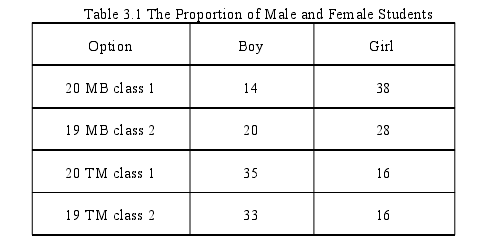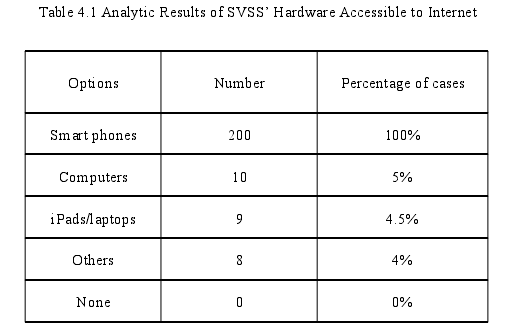本文是一篇英语毕业论文,本研究对网络环境下中职学生英语自主学习能力的现状进行了系统的调查。此外,本研究还通过访谈,深入分析了网络环境下影响中职学生英语自主学习能力的因素。
Chapter 1 Introduction
1.1 Background of the Research
In the new round of global scientific and technological revolution and industrial change,the integration of Internet and education has brought great historical developmentopportunities to English teaching in the Internet environment. In January 2017, the StateCouncil proposed the active development of “Internet Plus Education” and new forms of“Internet Plus Education” services. In the field of vocational education, the Ministry ofEducation issued the Guidance of the Ministry of Education on Further Developing theInformatization of Vocational Education in 2018, which pointed out that the modernizationand informatization of vocational education should be accelerated. As a part of vocationaleducation in a country with manufacturing as a significant industry, China’s secondaryvocational education shoulders the responsibility of providing a large number of employeesfor the construction of manufacturing power. English teaching in secondary vocationaleducation must be able to do its part to provide qualified industrial workers for the SmartManufacturing 2025 development strategy.
However, at present, most of the secondary vocational school students’ Englishfoundation is insufficient. They can not meet the requirements of the society for skilledvocational personnel. Many students’ English vocabulary is seriously insufficient (Cai Zengyi,2016). Their basic English knowledge is weak, with low listening and speaking level and stilllower motivation of learning English. The classroom atmosphere of English is not active. Inthis case, with the encouragement of teachers, or spontaneously, many students began to usethe Internet educational resources for autonomous English learning and have achieved somefruit. Still, there are also some problems in this process. For example, some students face alarge amount of Internet English learning resources. Some students do not know how tochoose. Some online English learning resources are very convenient, but there is a lot of highly entertaining content on the platform, which is easy to distract students’ attention. Thusthey subject to the interference of teachers, parents, and schools (Chen Qian, 2018). Studentsare learning the wrong way, and so on. Therefore, it is an urgent research topic for secondaryvocational education workers to explore how to make full use of the Internet environment toimprove the level of secondary vocational school students’ English autonomous learning andprepare them for future career development.
............................
1.2 Purpose and Significance of the Research
In this section, the purpose and significance of the research will be explainedrespectively.
1.2.1 Purpose of the Research
The purpose of the research is to investigate the current situation of secondary vocationalstudents’ autonomous English learning ability in the Internet environment, find out theiractual achievements and problems in English autonomous learning, analyze the factorsaffecting secondary vocational students’ English autonomous learning ability in the Internetenvironment, so as to sum up experience and put forward suggestions to solve the existingproblems.
(1) Theoretical Significance
Since China’s education departments stressed the need to strengthen the construction ofnetwork education resources system in 2011, Internet education has been developed for overten years, but the theoretical research on the autonomous learning strategies of secondaryvocational school students in the Internet environment is still relatively scarce. The currentresearch on secondary vocational school English teaching on Internet education environmentis often superficial or not truly localized.
The theoretical significance of this thesis first lies in the fact that it investigates the English autonomous learning in secondary vocational school from the perspective of Interneteducation environment, so it combines the theory of autonomous learning with the methods ofInternet environment education, making the theory enriched and further developed in width.Second, It integrated the theory of autonomous learning and the theory with the specificEnglish learning of the secondary vocational school students, so it has enriched and developedthe theory in depth. Third, this thesis redefines English autonomous learning in the Internetenvironment and sorts out relevant literature, which is helpful to systematize relevant theories.On this basis, this thesis carries out a field survey of students’ English autonomous learning ina vocational secondary vocational school, and analyzes the survey results with ConstructivismTheory and Autonomous Learning Theory, thus realizes the combination of theory andpractice and makes relevant theories have a more solid practical foundation.
....................................
Chapter 2 Literature Review
2.1 Brief Review of Autonomous Learning
This section will first give the definition of autonomous learning. Then the definition ofautonomous learning in the internet environment will be make clear. Finally, the classificationof autonomous learning in the internet environment will be introduced.
2.1.1 Definition of Autonomous learning
To discuss autonomous learning in the Internet environment, it should give a cleardefinition of the term autonomous learning first.
Henry Holec (1981), the father of autonomous learning, asserted that autonomouslearning is the ability to take charge of one’s own learning, and this kind of ability was notinherent but acquired by formal learning through natural channels or systems. Autonomouslearners have the ability to set their target of study, determine learning content and process,choose their own learning approaches and skills, monitor the study process such as time andplace, and meanwhile, evaluate learning effect.
Professor Zimmerman (1989) of the United States has a great influence on the definitionof autonomous learning and summed up the following three characteristics of autonomouslearning:
a. Emphasizing self-control, that is, planning, monitoring, and goal setting ofmetacognition;
b. Emphasizing behavior, that is, self-regulation of self-observation, self-judgment, and self-reaction;
c. Emphasizing the environment, which refers to the construction and utilization of thesurrounding environment.
...............................
2.2 Theoretical Foundations
This research mainly base on the following two theories: Humanism theory andConstructivism theory. They all provide a scientific theoretical source for the theory ofautonomous learning.
2.2.1 Humanism Theory
The main representatives of Humanism theory are Maslow and Carl R. Rogers.
Maslow put forward the theory of internal learning. Maslow believed that externallearning is passive and mechanical learning relying on reinforcement and conditioning. Anideal university should oppose external learning and advocate internal learning. The so-calledinternal learning relies on students’ internal drive, fully developing their potential andachieving self-realization.
Maslow once said, “the ideal university is a kind of education retreat so that you can tryto discover yourself, that is, to discover what you like and what you need, and what you aregood at doing, what you are not good at.” (Feng Zhongliang, 2004)
Rogers is also an outstanding representative of humanistic psychologists. Rogersbelieved that the ultimate goal of education is to cultivate the “all-around development ofpeople.” Therefore, in teaching, he strongly advocated “taking students as the center” toorganize various teaching activities. Only by taking students as the center can it be possible topromote students’ self-learning and self-realization, and it is possible to cultivate students’independence, autonomy, and creativity. Rogers put forward the concept of meaningful freelearning. For meaningful learning, Rogers thinks that meaningful learning means the wholeperson is involved in learning activities (Cristian Morosan, 2017). Such learning activities arespontaneous. It also means self-evaluation by students.

Table 3.1 The Proportion of Male and Female Students
.............................
Chapter 3 Research Design...................................... 17
3.1 Research Questions.............................17
3.2 Research Subjects......................................... 17
3.3 Research Instruments..................................17
Chapter 4 Results and Analysis................................................. 22
4.1 Overall Situation of SVSS’ English Autonomous Learning Ability in the InternetEnvironment...............22
4.1.1 Ability to Use Software and Hardware.......................... 22
4.1.2 Ability to Set Learning Objectives.............................26
Chapter 5 Conclusion.................................. 51
5.1 Major Findings..........................................51
5.2 Implications.......................................533
Chapter 4 Results and Analysis
4.1 Overall Situation of SVSS’ English Autonomous Learning Ability in the InternetEnvironment
In this section, the questionnaire results of autonomous learning ability in the internetenvironment of the secondary vocational school students will be presented and analyzed fromthe six dimensions of software and hardware, learning objectives, learning resources, learningmethods and strategies, self-control, and self-valuation.
4.1.1 Ability to Use Software and Hardware
(1) Hardware Facilities
Hardware Facilities are necessary tools for autonomous learning under the backgroundof Internet. After 2012, with the popularity of smart phones and mobile terminals, and thediversification of electronic devices, the frequency of students’ access to the Internet is higherand higher.(Zeng Qiang , 2019)
The first question of the questionnaire probes into the hardware facilities:
Question 1: The hardware equipment being able to surf the Internet that you ownincludes:

Table 4.1 Analytic Results of SVSS’ Hardware Accessible to Internet
..................................
Chapter 5 Conclusion
5.1 Major Findings
In this research, the situations of secondary vocational students’ English autonomouslearning ability in the Internet environment are systematically investigated. In addition,through interviews, this research makes an in-depth analysis of the factors that affectsecondary vocational school students’ English autonomous learning ability in the Internetenvironment. The findings are as follows:Through the investigation of question one, it is found that:
(1) The software and hardware conditions for secondary vocational students to learnEnglish autonomously in the Internet environment can meet their basic needs. Students havethe ability to accept and learn new network skills and are willing to try. However, there areproblems in the external support of teachers and parents. In terms of schools, there are stilldeficiencies in the construction of software and hardware facilities, such as the lack of freeWIFI supply, the lack of free campus network English resource library for students to learnindependently. Teachers cannot consciously guide students to use hardware and softwarefacilities for autonomous learning. Most of the parents of secondary vocational schoolstudents lack financial support and encouragement for students’ autonomous learning.
(2) In the aspect of the set learning objectives, it is found that most secondary vocationalstudents can set learning objectives for English autonomous learning in the Internetenvironment. However, most of the short-term learning goals they set are just to cope with theshort-term examination or to complete a certain English learning task. Secondary vocationalschool students are not specific enough and lack operability in setting learning objectives.Also, it is difficult for secondary vocational students to adjust their learning objectives in time according to the feedback of learning results.
reference(omitted)
